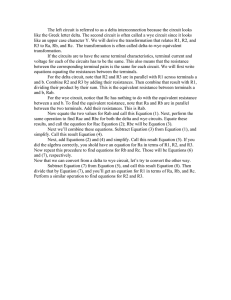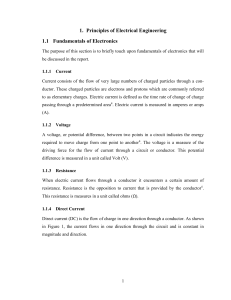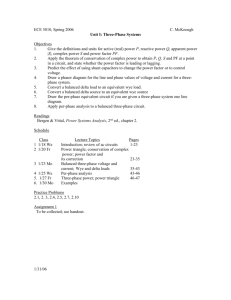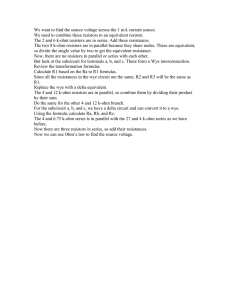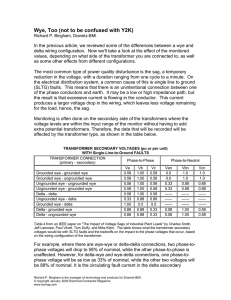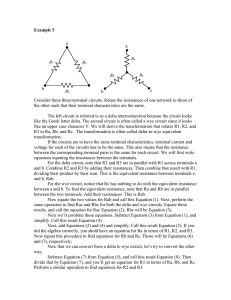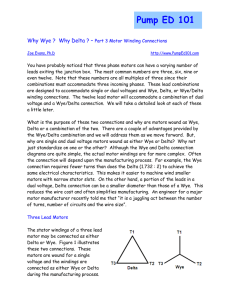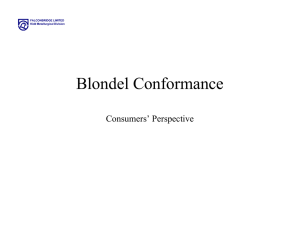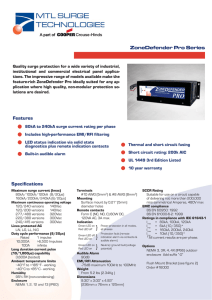Services Three Phase Service
advertisement
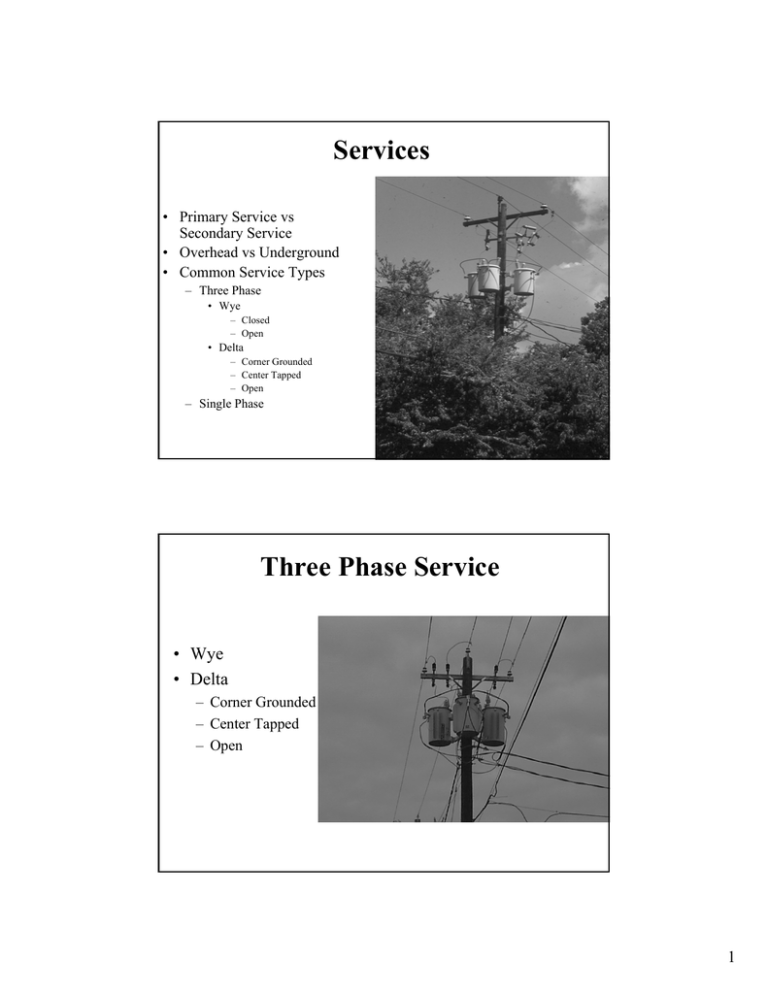
Services • Primary Service vs Secondary Service • Overhead vs Underground • Common Service Types – Three Phase • Wye – Closed – Open • Delta – Corner Grounded – Center Tapped – Open – Single Phase Three Phase Service • Wye • Delta – Corner Grounded – Center Tapped – Open 1 Wye Service • Customers needing three phase for some equipment and also having large amounts of single phase load • Many small commercial & industrial buildings • 208/120 Wye – 208 3 phase – 120 single phase • 480/277 Wye – 480 three phase – 277 single phase 3 Phase Wye System • 3 wires connect all at a common point which is grounded. • End points become the connection points for the 3 phases. • Y system – wye • 2 separate voltages – Phase to Phase – Phase to Ground 2 208/120 Wye • Smaller customers requiring mostly single phase and some 3 phase. • 480 volt services are more economical for larger motor loads. 480/277 Wye • Voltages – 480 volts phase to phase – 277 volts phase to ground • Requires step down transformer to produce 120 volts for receptacles • 277 volt lighting fixtures are available 3 3 Phase Delta Systems • Generally built to areas with mostly 3 phase load and not much single phase load. (oil pumping, irrigation, etc.) – Advantages: Expense of one less wire to build and maintain. – Disadvantage: Unbalanced voltages from amounts of single phase load. • Phases connected end to end – Each phase relies on the sharing of one wire as a supply and return path for the others. – Voltage the same between any 2 wires • Popular for ungrounded systems Center-Tapped Delta • Customers with mostly three phase equipment and very little single phase equipment. A – Manufacturing & processing facilities • 240/120 CT Delta – Smaller 3 Phase Services with mostly 3 phase load. C – 240 three phase – 120 single phase • 480/240 CT Delta – Larger 3 Phase Services with mostly 3 phase load. B G Neutral Wire • 480 three phase – 240 single phase • High or Wild Leg 4 Corner Grounded Delta • 240 or 480 volts. • Usually only for 3 Phase Motor/Pumping Load. – Oil Pumps – Irrigation Pumps – Municipal Water A G B C Open Delta • Uses only 2 transformers • Often from a VPhase Distribution Line. Open Wye Primary to Open Delta Secondary Open Wye (V Phase) Primary A C N H1 – Wye with 2 Phases and a Neutral. • Less Expensive • Light 3 Phase H2 X1 X3 X2 H2 H1 X1 X3 X2 a b c n 3 Phase 4 Wire Open Delta Secondary: 120/240, 240/480, etc for lights and power 5 Single Phase Service • 120/240 volt service. • Neutral attached to center bushing in transformer. – 120 volts Hot to Neutral – 240 volts Hot to Hot Single Phase from 3 Phase Systems • Individual single phase loads can be connected and balanced to resemble a 3 phase load. • Voltages will be different in Wye & Delta systems • If not balanced, voltage unbalances will result. 6 Secondary System • • • • • • • • Transformer Service Drop Meter Loop Meter Ground Rod Main Breaker Box Circuits Service Drop • Overhead: – Service Drop • Underground: – Service Lateral • Three Phase: – 3 or 4 wires • Single Phase: – 2 or 3 wires • Triplex • Quadraplex 7 Meter Loop • A Meter Loop is comprised of: – Weatherhead – Service Mast/Riser – Meter Base/Can Meter • The Cash Register • Owned by Utility • Installed in customer’s equipment. 8 Main Disconnect • Today, electrical codes require some type of disconnect device (switch) to shut off all the circuits supplied by the disconnect. • Usually a “Main Breaker” in the breaker box. • Older or larger facilities may have “Main Disconnects” rather than main breakers. Ground Wire/Rod • Most electrical systems in North America are grounded for safety and lightning protection. • Their is generally a ground wire/rod at the: – Service transformers. – Meter Base – Breaker Box • Formal Names: – Grounding System Conductor (wire) – Grounding System Electrode (rod) 9 Breaker/Fuse Box • Formally called the “Service Entrance Panel” • Provides a location for breakers or fuses to protect the individual circuits in the facility. • Some larger customers have “Sub-panels” which contain breakers and fuses. Circuits • Feeders – circuits supplying services or sub-panels. – the service drop is a “feeder”. • Branch Circuits – Individual Branch Circuit • Circuit to one piece of equipment – Appliance Branch Circuit. • Circuit to several fixed appliances – Lighting Branch Circuit • Circuit supplying only lighting fixtures. – General Purpose Branch Circuit • Circuit to receptacles and lights. 10
